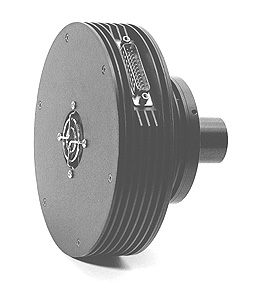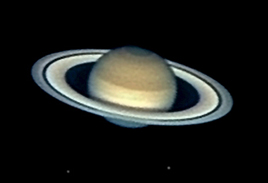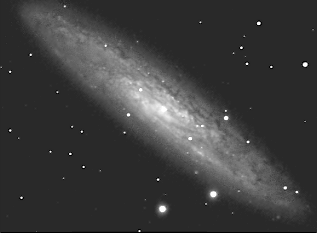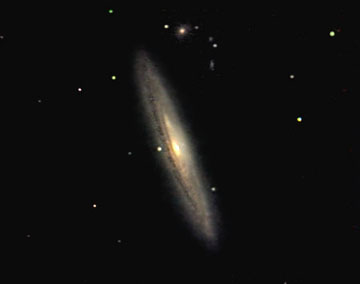 |
ST-6B CCD IMAGING |
| CCD Imaging Cameras | ST-237A | ST-5C | ST-6B | ST-7XE | ST-8XE | ST-9XE | ST-10XE | ST-1001E | ST-2000XM |
| Video Camera / Autoguider | |||||||||
| Industrial / Scientific | |||||||||
MODEL ST-6B |
[ Note: This page is for reference only. The ST-6B has been discontinued and replaced with the ST-9XE ]
| Camera Model |
Pixel Size |
Pixel Array |
Detector Size |
Download Time |
Interface | Dark Current @ -30C |
Read Noise |
Full Well Capacity |
Self- guiding |
| ST-9XE | 20 x 20 u | 512 x 512 | 10.2 x 10.2 mm | ~1 sec | USB | ~1e- | 13e- | 150,000 | Yes |
| ST-6B | 23 x 27 u | 375 x 241 | 8.6 x 6.5 mm | ~25 sec | Serial | ~10e- | 23e- | 400,000 | No |
 |
ST-6B CCD IMAGING |
The Model ST-6B was a successful product from the moment it became available. Following its introduction, for a period of years, it was in wider use than any other cooled low light level CCD imaging camera in the world. It's popularity by both amateur and professional astronomers was clearly proven by the hundreds of discoveries that have been published based on observations and images with this instrument. Discoveries ranging from Near Earth Asteroids and Supernova monitoring to the study of Gamma Ray Burster error boxes and distant Globular Clusters.
The ST-6B is still in use throughout the world. However, for those interested in
a relatively inexpensive large pixel array with high sensitivity, the ST-9E offers better
performance. The ST-9E also includes SBIG's patented dual sensor self-guiding, a
feature not available on the ST-6B. For these reasons, the ST-6B has been
discontinued and replaced by the ST-9E.
 |
| Saturn. Color image captured with a Model ST-6 CCD camera and color filter wheel. Taken through a C14 telescope at f/60 using eyepiece projection. Courtesy Ed Grafton |
The Model ST-6B will reveal spiral structure in hundreds of galaxies with 1 to 5 minute
exposures at the prime focus of an 8 inch f/10 telescope. Planetary nebulae become easy
objects. Stellar photometry down to 18th magnitude can be easily accomplished. The
imaging camera is used in conjunction with an IBM PC compatible or Macintosh computer
which allows the images to be easily displayed and processed. The ST-6B uses a proprietary
two stage thermoelectric cooler design. The CCD temperature is user selectable and
regulated to 0.1 degree. A regulating thermistor on the CCD stabilizes the
temperature for long periods allowing low dark current operation. As a result, the ST-6B
is capable of one hour exposures that are typically sky background limited.
 |
| NGC 253. Twenty 30 second exposures were combined to create this ST-6 image taken through a C8 telescope operting at f/6.3. Courtesy of Ed Grafton |
The ST-6B incorporates a unique feature called Automatic Track & Accumulate (TRACCUM),
allowing automatic guiding of long integrated images. In the TRACCUM mode the ST-6B will
take an exposure, determine the position of a preselected star, add the image to the image
sum building in an internal memory buffer, correct the telescope's position and then start
the cycle over again. In this mode up to 64 images can be co-added. The resulting exposure
is almost as good as a single long exposure, dependent on the exposure used and the actual
sky conditions. The great sensitivity of the CCD virtually guarantees that there will be a
usable guide star within the field of view. This patented feature provides dramatic
performance and makes long exposures easy.
 |
| NGC 4216. This color image was captured with an ST-6
camera and color filter wheel through a C14 telescope operating at f/7. Courtesy Ed Grafton |
The ST-6B allows the user to pursue challenging photometric and astrometric tasks which
previously required expensive photomultipliers, and precise microscopes with expensive
translation stages. These functions, which are part of the CCDOPS operating software
furnished with each imaging camera, include variable star photometry, precise asteroid
monitoring, and even spectroscopy. The CCD does more than just capture images with great
sensitivity; it enables accurate brightness data to be extracted, a third dimension to all
images shown here, a dimension which is very difficult to obtain from film.
Model ST-6B CCD Specifications
| CCD | TI TC-241 |
|---|---|
| Pixel Array | 375 x 241 pixels, 8.6 x 6.5 mm |
| Total Pixels | 91,000 |
| Pixel Size | 23 x 27 microns |
| Full Well Capacity | 400,000e |
| Dark Current | 10e¯/pixel/sec at -30° C |
| Antiblooming | Variable Rate |
Readout Specifications
| Shutter | Electronic + EM Dark Vane |
|---|---|
| Exposure | 0.01 to 3600 seconds, 10ms resolution |
| Correlated Double Sampling | Yes |
| A/D Converter | 16 bits |
| A/D Gain | 6.7e¯/ADU |
| Read Noise | 23e¯ RMS |
| Binning Modes | 1 x 1, 1.5 x 1, 1.5 x 2 |
| Pixel Digitization Rate | 8 KHz |
| Full Frame Acquisition | under 25 seconds |
Optical Specifications (8" f/10)
| Field of View | 14.9 x 11.3 arcminutes |
|---|---|
| Pixel Size | 2.4 x 2.8 arcseconds |
| Limiting Magnitude | Magnitude 14.5 in 1 second |
| (for 3 arcsec FWHM stars) | Magnitude 18 in 1 minute |
System Specifications
| Cooling | Two Stage Thermoelectric Active Fan, -55 from Ambient Minimum |
|---|---|
| Temperature Regulation | ±0.1°C |
| Power | 12 V AC/DC 4 amps, Transformer included |
| Computer Interface | Serial (RS-232, RS-422) |
| Computer Compatibility | PC - MS-DOS, Windows 95 or Macintosh |
| Guiding | Autoguiding and Track & Accumulate |
Physical Dimensions
| Optical Head | 6 inches diameter x 3 inches deep 15 cm diameter x 7.5 deep 2.5 pounds/1.1 Kg |
|---|---|
| CPU | 6 x 9 x 2.5 inches / 15 x 23 x 6.3 cm 2 pounds/0.9 Kg |
| Mounting | T-Thread, 1.25" and 2" nosepieces included |
| Backfocus | 0.64 inches/0.6 cm |
Price
[ DISCONTINUED ] |
Revised: September 11, 2002 03:44:19 PM.
Copyright © 1998 Santa Barbara Instrument Group, Inc. All rights reserved.
Please report any problems with this page directly to the Webmaster